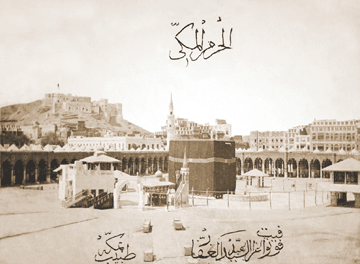
[Illustration: The ka‘ba in Mecca during the period of Ottoman Sultan Abdulhamit II.]
[Editor’s Note: As the holiest location in the Muslim World, the Arabian city of Mecca is prohibited territory for any non-Muslim. Over the years a number of travelers disguised themselves and visited the sacred enclosure of the ka’ba, most notably Johann Ludwig Burckhardt (1784-1817), who made his overture in 1812, and Richard Burton in 1853. In 1877 an Englishman named John Keane entered Mecca. His travel account is available online. Here is the story of that surreptitious visit, as told by Robin Bidwell.]
John Fryer Keane was the son of a clergyman and had run away to sea at the age of twelve. He spent most of the next nine years among Muslims, mainly as an officer on ships with Indian crews. He arrived at Jedda, attached himself to the suite of an Indian prince and after six weeks in Mecca felt as completely at home as if he had been there all his life. No one commented upon his fair skin for, as he said, the visitors were so varied that it looked like Madame Tussaud’s out for a walk and the spectacle of the Archbishop of Canterbury in a mitre would really have caused no comment. He wandered around happily, peering in through a school window to see the boys having the soles of their feet beaten in batches of five and chattering with a Muslim lady who, as Miss McIntosh, had been taken prisoner during the Indian Mutiny.
He was deeply impressed by the religious sincerity of the pilgrims and the deep spirituality that it engendered, but he cared much less for the resident population. All, he said, were beggars: “Bakshish†roars the camel; “bakshish†brays the ass; “bakshish†yells the cur, till, after passing through a stage where you fancy you hear nothing else, you get so accustomed to it, that it costs you an effort of will to hear it.’ His dislike for them was increased when one day he was wandering around as ‘an Eastern swell’ in a bright white tunic and a huge turban, a child for no apparent reason said ‘Look at that Christian.’ A loafer, in the hope of gain, demanded a profession of faith from him and Keane seized his shoulders, spun him round and delivered a solid kick—‘I could not have perpetrated a more un-Muhammadan act.’ A crowd started to stone him so, snatching up a child as a shield, he made for the local police station. There he claimed to be a Muslim and his fluency in cursing convinced the authorities who escorted him back to his lodgings.
Keane’s troubles were not yet over. He went on to Medina and on the way was settling down to a tasty stew when a Beduin, who had just finished a particularly revolting operation on his camel, approached and after wiping his hands on ‘his offensive mat of hair’, plunged ‘his loathsome paw slap into the middle’ of the Englishman’s dish. In a frenzy of rage, Keane hurled the plate at the Arab with such violence that it knocked him down. A few moments later the Beduin crept up upon him and thrust a spear so deeply into his leg that he almost bled to death on the spot. A last memory before losing consciousness was that of three vultures wheeling optimistically above. However, a local wise man plugged the wound with raw cotton and not long afterwards Keane was able to walk into Medina. Medina, he thought, ranked at first sight with Constantinople for beauty but on further acquaintance he, like Burton, found the Prophet’s Mosque tawdry.
After his return he wrote in his autobiography, ‘I had performed the fearfully risky pilgrimage to Mecca with but one purpose: and that was by performing a feat to bring my name forward as a capable traveler, it would stand me in good stead as recommendation for the support and means I should require to advance my long-cherished designs on Papua.’ It is not clear if he ever achieved this ambition but during the next few years he was imprisoned in Brazil, edited a newspaper in Shanghai, worked for the Indian Railways, prospected in Burma and lived as a tramp in England. He was last heard of cutting sugarcane in Queensland. His books are lively and full of arresting turns of phrase: it is not difficult to visualize the beauty of the lady whose face looked like ‘three kicks in a mud wall.’
Excerpt from Robin Bidwell, Travellers in Arabia (London: The Hamlyn Publishing Group), pp. 127-129, 1976